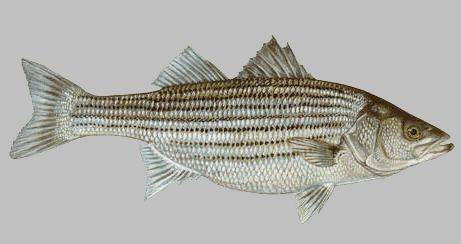
Stripers
The "BIG BAD BOY" of Oklahoma!
STRIPERS have been widely introduced in numerous lakes, rivers, and impoundments throughout Oklahoma. Stripers prefer relatively clear water with a good supply of open-water baitfish. Their preferred water temperature range is 65 to 70 degrees.

World Record: 78.5 pounds, caught in Atlantic City, New Jersey in 1982
Oklahoma's Record: 47 lbs. 8 ozs.
Description: The striper is the largest member of the temperate bass family. Body coloration is olive-green to blue-gray on the back with silvery to brassy sides and white on the belly. It is easily recognized by the seven or eight prominent black uninterrupted horizontal strips along the sides. The stripes are often interrupted or broken and are usually absent on young fish of less than six inches. The striper is longer and sleeker and has a larger head than its close and similar looking relative, the white bass, which rarely exceeds three pounds.
Other Names: striper, rockfish, rock, line sides
Spawning Habits: The Striper spawn in March, April, and May when water temperatures reach 60 to 68 degrees. Stripers are river spawners that broadcast millions of eggs in the water currents without affording any protection or parental care. During spawning, seven or eight smaller males surround a single, large female and bump her to swifter currents at the water surface. At ovulation, ripe eggs are discharged and scattered in the water as males release sperm. Fertilized eggs must be carried by river currents until hatching (about 48 hours) to avoid suffocation. Fry and fingerlings spend most of their time in lower rivers and estuaries. Because striped bass eggs must remain suspended in a current until hatching, most Oklahoma impoundments are unsuitable for natural production. Freshwater populations have been maintained by stocking fingerlings, and, despite initial difficulties in hatchery procedures for obtaining females with freely flowing eggs, a modern technique of inducing ovulation with the use of a hormone has been successful.
Feeding Habits: Striper are voracious feeders and consume any kind of small fish and a variety of invertebrates. Preferred food for adults mainly consists of gizzard and threadfin shad, golden shiners, and minnows. Younger fish prefer to feed on amphipods and mayflies. Very small stripers feed on zooplankton. Like other temperate bass, they move in schools, and all members of the school tend to fee at the same time. Heaviest feeding is in early morning and in the evening, but they feed sporadically.